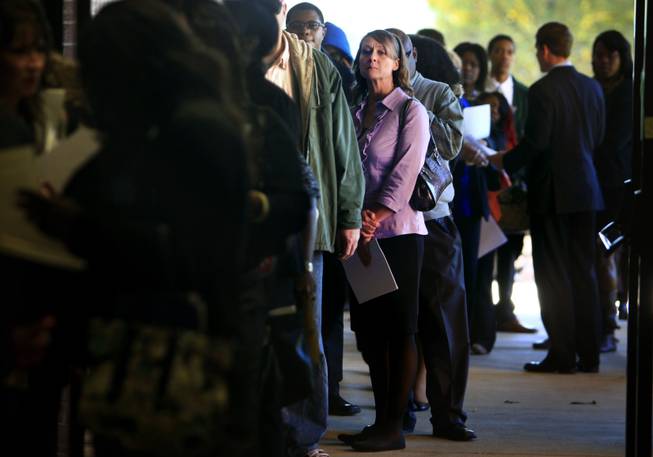
Jim Weber/Commercial Appeal/AP
In this Nov. 7, 2013, photo, Jona Caldwell joins a long line of job seekers outside Ferguson Community Center in Cordova, Tenn.
Friday, March 9, 2018 | 12:30 a.m.
WASHINGTON — The February U.S. jobs report being released Friday will help address a question on the minds of many: Is worker pay finally accelerating?
January's jobs data had shown the sharpest year-over-year average pay increase in eight years. That news ignited a sustained sell-off in stocks on fears that inflation might be picking up.
In the week that followed the release of the January wage data, traders sent stock prices tumbling 10 percent — deep enough to qualify as a "correction" — for the first time in two years. And bond yields surged to their highest levels in four years. That increase reflected anticipation that the Federal Reserve might step up its rate hikes to control inflation.
A broad and sustained pickup in pay gains is considered good news by most people, especially since average wage increases have been mostly stagnant since the Great Recession ended in 2009. But Wall Street worries that an acceleration in pay would force companies to raise prices to cover their higher labor costs.
Higher corporate expenses could, in turn, depress profits and intensify inflation pressures. And if the Fed followed by raising short-term rates more quickly, the economy could slow and bonds would become more attractive relative to stocks.
Most economists foresee a slightly more tepid wage figure this time: They have forecast that the government's February jobs report will show that average hourly wages grew 2.8 percent in February from 12 months earlier, down slightly from the 2.9 percent increase in January. It's possible, too, that January's wage increase will be revised lower on Friday.
"There's been so much talk about inflation now that unless it's a meaningful surprise to the upside, the market can absorb a stronger economy coupled with higher wages," said Quincy Krosby, chief market strategist at Prudential Financial. "The real inflationary impact tends to come when wages move up by 4 percent. We're not there."
Economists have forecast that the report will show employers added a solid 200,000 jobs in February, the same as in January, according to data provider FactSet. They have also predicted that the unemployment rate dipped to a low 4 percent from 4.1 percent, where it's remained for four months.
But when the report is released at 8:30 a.m. Eastern time, attention will be fixed mainly on the wage figure.
"I think they'll be watching that closer than any data point I can remember as of late," said Emily Roland, head of capital markets research for John Hancock Investments.
January's sharp wage increase might have reflected, in part, temporary factors. Some economists note, for example, that freezing temperatures that month might have kept many lower-paid workers off the job by shutting down construction sites and reducing retail and restaurant business. If so, the one-time loss of those lower-paying jobs might have given average overall pay increases an artificial boost in January.
In the meantime, economists are calculating how the Trump administration's decision Friday to impose a 25 percent tariff on steel imports and a 10 percent tariff on aluminum might affect the job market. The Trade Partnership, a consulting firm, estimates that the tariffs will eliminate roughly 145,000 jobs.
Steel and aluminum producers would hire more people. But the gains would be more than offset, the firm calculates, by sharp losses among companies that use the metals, such as automakers, packaged food companies and those that make industrial machinery.
During 2017, the stock market, as measured by the S&P 500 index, surged 19 percent, partly on anticipation of corporate and individual tax cuts. Yet barely a month after the tax cuts became law, investors shifted their focus to the potential consequences: Faster growth that might intensify inflation and lead the Fed to accelerate its rate hikes.
There have been some signs that price pressures are picking up. But overall, inflation remains in check. The inflation gauge that the Fed tends to monitor most closely shows an increase of just 1.7 percent from a year earlier, below the central bank's 2 percent target level.
Most economists expect growth to pick up in the coming months and to accelerate inflation slightly by year's end. They have forecast that the economy will expand at just a 2 percent annual rate in the January-March quarter before topping 3 percent in the next two quarters.
For now, consumers have pulled back somewhat on spending despite income gains, thereby setting the stage for potentially stronger spending gains in coming months. After-tax incomes in January — which include benefit payments from the government and business income as well as wages — climbed by the most in a year. They were boosted, in part, by the Trump administration's tax cuts and company bonuses that were paid out in response to corporate tax cuts.
And manufacturers expanded at the fastest pace in nearly 14 years in February, according to a survey of purchasing managers.
